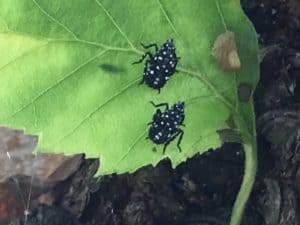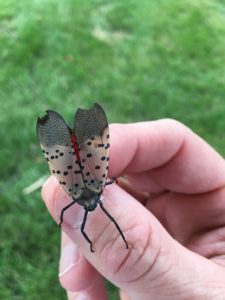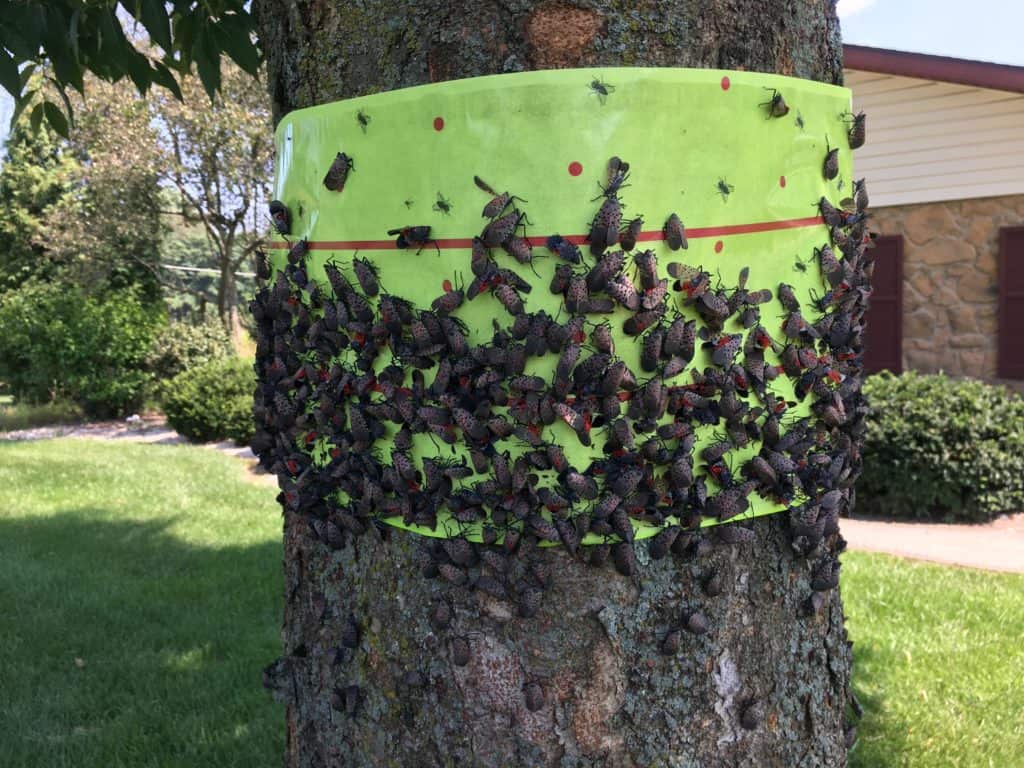How to Treat the Spotted Lanternfly
How to Treat for Spotted Lanternflies
Updated July, 2020
All information below is based on what we know about the Spotted Lanternflies at this time. Lanternflies are still  considered an emerging pest and they are an unusual pest – which makes them harder to understand. As we learn more about this interesting but destructive pest, we will provide updates.
considered an emerging pest and they are an unusual pest – which makes them harder to understand. As we learn more about this interesting but destructive pest, we will provide updates.
The good news is that, due to research performed by Penn State and other universities, we have learned a lot about how to control the lanternflies.
The two primary ways to effectively kill Spotted Lanternflies are:
- Soil injection – a process where an insecticide is delivered to susceptible tree or shrub through the roots of the plants. The roots absorb the insecticide and the material moves up, through the living parts of the plants and into the canopy.
Just to clarify, Soil injection can also be used to distribute nutrients (fertilizer) and other beneficial materials to the root zone of plants. For the purpose of this article however, we will just be referring to insecticides for Lanternfly control.
- Foliar spray– this is the process of spraying the tree with an insecticide.
There are many insecticides being used to treat spotted lanternflies however, they are not equal. It is important to use the right material to avoid disappointing results.
So, what works the best?
We have evaluated the results of each method (and the combination of both) and here is what we have learned:
- Soil Injection only – Soil injection is done in the spring* – before damage is done to the trees and shrubs. Also, the insecticide injected doesn’t wash off in the rain. These are both major benefits of soil injections.
 The injections work well to protect the treated trees and shrubs but large populations of Lanternflies often continue to harbor (live) on the plant materials. Fortunately, it appears as though lanternflies harboring on an injected plant feed less than lanternflies on untreated plants. However, the harboring populations will still breed, spread to other plants and become a nuisance due to the sheer volume of the populations.
The injections work well to protect the treated trees and shrubs but large populations of Lanternflies often continue to harbor (live) on the plant materials. Fortunately, it appears as though lanternflies harboring on an injected plant feed less than lanternflies on untreated plants. However, the harboring populations will still breed, spread to other plants and become a nuisance due to the sheer volume of the populations.
Timing of soil injections is important
Timing is another consideration (and sometimes a stumbling block). Soil injections need to be done between mid-late March and mid-late May (preferably early to mid-May). In reality, the timing is determined by the plant and the weather – not the calendar – read on…
The earliest soil injections can be done is at “bud swell”. This is when the plants begin emerging from dormancy and the buds start growing – they “swell”. This is typically in the later part of March.
Once the leaves of the trees/shrubs are fully extended (have grown to their full size) an injection will not be fully  effective. This is typically late May. The issue is, when the leaves are fully extended, it can take up to three months for the material to reach all parts of a tree. While the plants will have the benefits of the injection late in the season (when the Lanternflies are adults), the plants should be considered unprotected in June, July & August.
effective. This is typically late May. The issue is, when the leaves are fully extended, it can take up to three months for the material to reach all parts of a tree. While the plants will have the benefits of the injection late in the season (when the Lanternflies are adults), the plants should be considered unprotected in June, July & August.
*Although being proactive by scheduling your soil injection early is vital, we now have systemic insecticide options that can be performed anytime during the growing season. The absorption rate is much quicker, and it works much like the soil injection. However, it is more costly than traditional soil injection.
- Spray Program only (three treatments) – The positives are: it works fast, provides immediate ‘knock-down’ of lanternflies at the time of spraying and has a residual affect (it continues to work after the treatment).
The downsides are, the residual period is short and, spraying is not always possible.
Rain and sunlight breakdown the material which reduces the residual period. Due to this, we schedule the three treatments about 4-6 weeks apart. We have varied the spacing of the treatments when, for unknown reasons, the populations seem to decline or increase. We watch what is going on and get feedback from our technicians daily and will adjust the schedule to make the treatments as effective as possible.
To put the frequency of the spray treatments into perspective, people and companies that rely on plants susceptible to Lanternfly damage for their livelihood such as orchards & vineyards typically spray on 10-14 day intervals. We have found that 4-6 weeks is adequate on ornamental trees and shrubs. Any feeding that occurs prior to the upcoming application has been inconsequential. If we find that this schedule is not keeping up with the pressure, we will provide new recommendations to our customers.
With large trees that are near a property line, there can be issues with the spray drifting onto neighboring properties – which is a “no-no” (unless the property owner gives us permission). In these cases, we can usually can treat some of a tree but not all of it – which leaves a portion of the tree unprotected.
- Soil Injection only – The combination of soil injection along with the spray treatments was the clear winner. It hits this invasive pest with a one-two punch. At
 this point, we do not know of any better solution.
this point, we do not know of any better solution.
That being said, if you just want to use one method, the soil injection alone seems to do a better job than the spray program at protecting the plants. Keep in mind that, in the last couple years, we have had a lot of rain throughout the entire summer. Since rain breaks down sprayed-on applications we may see better results from the spray treatments in dry (or dryer) years.
Hiring a trained professional to do the treatment is important. These treatments must be applied correctly, with the right insecticides and at the right time of year in order for the tree to properly absorb it. A Green Giant tree technician can determine the best option based on your situation.
As you can see, there are benefits and drawbacks to both treatment methods.
Additional Benefits of Soil Injection:
Preserves Beneficial Insects
Soil injection does not harm non-target insects. There are hundreds of insects on trees that provide necessary ecological functions and it is important to preserve these beneficial insects. The only insects that are impacted by soil injection are those that are feeding on and damaging the tree.
Eliminates Spray Drift
Soil injections eliminate spray-drift. That is, when spraying a tree, sometimes the material will drift to non-target locations.
While the target of the treatment is Spotted Lanternflies, the injected plants will also have protection from other chewing pests such as Japanese Beetles.
Other ways to help reduce Spotted Lanternfly infestations
 Banding – Tree banding is a way to help reduce the number of Spotted Lanternflies in the ‘crawler’ stage. (Yes, this is when they crawl, after the egg stage and before they can fly).
Banding – Tree banding is a way to help reduce the number of Spotted Lanternflies in the ‘crawler’ stage. (Yes, this is when they crawl, after the egg stage and before they can fly).
Banding a tree consists of attaching a sticky ‘band’ around the trunk of a tree. This band can be duct tape (or a similar material) attached to the tree with the sticky side facing out.
When the insects crawl up and down the tree, they will get stuck on the tape.
What we have noticed is that the lanternfly crawlers do not actually crawl down the tree – they mostly get blown or knocked off the tree then crawl back up. This is obvious when you see the insects sticking to the bottom portion of the band and not the top.
Lanternflies typically hatch in late spring so the bands should be on the trees by April or early May to be most effective.
One problem that needs to be considered is that birds can sometimes get stuck on the tape. It is best to use a material that is sticky enough to catch the lanternfly crawlers but not so strong that it will harm birds.
Another approach that can reduce the number of lanternflies is to scrape the egg masses off the tree and into a zip lock bag. Have some rubbing alcohol in the bag and soak the eggs to kill them. Using a putty knife or a plastic card can easily remove the egg masses.
Neither the banding nor the scrapping of egg masses will eliminate the problem but, it may reduce the populations enough to make it worth the effort.
Do I really need to treat my trees for the lanternflies?
![]() It is a good idea to treat any trees that are infested with Spotted Lanternflies. Spotted Lanternflies can kill your trees and it is much less expensive to treat them than it is to replace them. But, even if you have an infested tree(s) that you don’t want to save, it is still good to treat because it will help reduce the population of this damaging insect whose population is exploding.
It is a good idea to treat any trees that are infested with Spotted Lanternflies. Spotted Lanternflies can kill your trees and it is much less expensive to treat them than it is to replace them. But, even if you have an infested tree(s) that you don’t want to save, it is still good to treat because it will help reduce the population of this damaging insect whose population is exploding.
Contact us to find out more about what can be done to decrease the Spotted Lanternfly population.